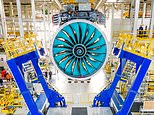
Rolls-Royce has finished building its UltraFan demonstrator engine, which could improve aircraft fuel efficiency by up to 10 per cent.
The motor boasts a 12 foot (140 inch) fan system, the largest in the world, and is designed to be run on 100 per cent Sustainable Aviation Fuel.
It has now been transported from the workshop and into Testbed 80 – a £90 million ($109.5 million) facility in Derby, purpose built for the UltraFan.
The British company now hopes to perform its first test early next year, which could lead to the application of the technology in its current family of Trent engines.
Rolls-Royce has finished building its UltraFan demonstrator engine, which could improve aircraft fuel efficiency by up to 10 per cent
The motor boasts a 12 foot (140 inch) fan system, the largest in the world, and is designed to be run on 100 per cent Sustainable Aviation Fuel
WHAT IS THE ULTRAFAN ENGINE?
The Ultrafan is a demonstrator engine with a 12-foot (140 inch) fan system, that has cost over £500 million to build.
It is designed to be run on Sustainable Aviation Fuel, and may help improve aircraft fuel efficiency by up to 10 per cent when fitted.
The UltraFan boasts carbon composite fan blades with a titanium sheath to help protect them from object damage and bird strikes.
These materials help to reduce its weight and boost fuel efficiency.
It also has a new power gearbox, lean burn combustor and Advance3 core architecture helping to provide a very high propulsion efficiency.
Chris Cholerton, President of Rolls-Royce Civil Aerospace, said: ‘Seeing the UltraFan demonstrator come together and getting ready for test in Testbed 80 is a great way to end the year.
‘We have all been waiting for this moment, which is such an important milestone for the programme and for the team who have worked on it.
‘The next stage will be to see UltraFan run for the first time on 100 per cent Sustainable Aviation Fuel in 2023, proving the technology is ready to support more sustainable flight in the future.’
The UltraFan has cost over £500 million to complete, thanks to its combination of state-of-the-art technology and materials.
It boasts carbon composite fan blades with a titanium sheath to help protect them from object damage and bird strikes.
These materials help to reduce its weight and boost fuel efficiency.
It also has a new power gearbox, lean burn combustor and Advance3 core architecture, helping to provide a very high propulsion efficiency.
The UltraFan has delivered 64 MW of power in tests, which is a record in the aerospace industry, and equivalent to the requirements for a city the size of Bath.
Once scaled up, it will be capable of a thrust range between 25,000 lbs (11,000 kg) and over 100,000 lbs (45,000 kg).
Rolls-Royce intend to begin building narrowbody and widebody aircrafts equipped with the UltraFan engines in the 2030s
The new engine offers a 25 per cent increase in fuel efficiency compared to the first-generation of Trent turbofans
Rolls-Royce intends to begin building narrowbody and widebody aircrafts equipped with the UltraFan engines in the 2030s.
Prior to then, the manufacturer plans to begin equipping its current Trent aircraft engines with UltraFan technologies to reduce emissions.
The new engine offers a 25 per cent increase in fuel efficiency compared to the first-generation of turbofans.
It also produces 40 per cent less nitrogen oxides, 35 per cent less noise and almost zero non-volatile particulate matter at cruise.
The Sustainable Aviation Fuel the UltraFan will run on uses 80 per cent less carbon throughout its life cycle than traditional jet fuel.
Rolls-Royce is currently testing its other engines with a 10 per cent blend of this fuel, to help phase it in to operations.
The UltraFan boasts carbon composite fan blades with a titanium sheath to help protect them from object damage and bird strikes
The UltraFan has delivered 64 MW of power in tests, which is a record in the aerospace industry, and equivalent to the requirements for a city the size of Bath
The UltraFan also produces 40 per cent less nitrogen oxides and 35 per cent less noise than the Trent engines, as well as almost zero non-volatile particulate matter at cruise
Once scaled up, the UltraFan will be capable of a thrust range between 25,000 lbs (11,000 kg) and over 100,000 lbs (45,000 kg)
This is not Rolls-Royce’s first foray into improving the sustainability of its aircrafts.
Last month, the company successfully trialled a jet engine that is powered by hydrogen.
The engine used was a converted Rolls-Royce AE 2100-A, and was started up and ran using hydrogen extracted from water using renewable energy.
Hydrogen itself is considered a ‘green’ fuel, because when it is burnt in air it only produces water, as opposed to greenhouse gases like carbon dioxide.
While there are a few problems yet to solve before planes will take off using the green fuel, the trial is a world first and regarded as a ‘new aviation milestone’.
The engine used was a converted Rolls-Royce AE 2100-A, and was started up and ran using hydrogen that was extracted from water using renewable energy
Airplanes are normally powered using the fossil fuel kerosene, and a Boeing 737-400 currently produces about 200 lbs (90 kg) of carbon dioxide per passenger per hour.
Air travel is responsible for 3.5 per cent of human’s impact on global warming, and so many companies are searching for green solutions.
Rolls-Royce has also been looking into battery technology for its all-electric plane, which could fly for 30 minutes on a single charge.
These projects have likely been motivated by the ‘Race to Zero’ campaign that the firm has signed up to.
It means it has committed to achieve net zero carbon emissions by 2050 by meeting a set of strict criteria, including taking immediate action.
Achieving net zero by 2050 ‘at the very latest’ is in line with the scientific consensus on limiting warming to 2.7°F (1.5°C), set out in the Paris Agreement in 2015.
If you enjoyed this story, you might like…
Find out about how Airbus is developing a hydrogen-powered fuel cell engine as a potential solution for its zero-emission aircraft.
Scientists have achieved the holy grail of ‘net energy gain’ in nuclear fusion by producing more energy than was used to activate it.
And, a space tourism firm has completed the first successful test flight of its balloon, which saw it float 23 miles (37 kilometres) into the stratosphere.
Santa’s sleigh would need an engine like NASA’s Saturn V rocket
If there are any disbelieving children out there who don’t believe in Father Christmas, a new scientific study could change their mind.
Physicists say Santa’s sleigh could potentially fly if it had a few major modifications, including a pair of wings similar to those on a commercial aeroplane.
Santa’s sleigh would need an engine with the equivalent thrust to that produced by NASA’s Saturn V rocket or 150 Boeing 747-400 airliners, they’ve calculated.
It would also have to move at 12,300 miles per hour (5,500 metres per second) – around 10 times the speed of sound – in order to generate enough lift.
Read more here
Physicists say Santa’s sleigh could potentially fly if it had a few major modifications, including a pair of wings similar to those on a commercial aeroplane and an engine with the equivalent thrust to that produced by NASA’s Saturn V rocket or 150 Boeing 747-400 airliners
Source link
CHECK OUT: Top Travel Destinations
READ MORE: Travel News



